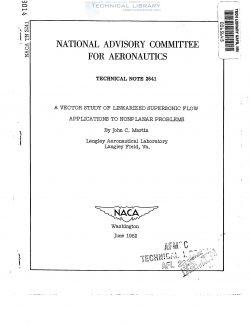naca-tn-2641
- Version
- 148 Downloads
- 2.10 MB File Size
- 1 File Count
- January 17, 2017 Create Date
- January 17, 2017 Last Updated
National Advisory Committee for Aeronautics, Technical Notes - A Vector Study of Linearized Supersonic Flow Applications to Nonplanar Problems

A vector study of the partial-differential equation of steady
linearized supersonic flow is presented. General expressions, which
relate the velocity potential in the stream to the conditions on the
disturbing surfaces, are derived. In connection with these general
expressions the concept of the finite part of an integral is discussed.
A discussion of problems dealing with planar bodies is given and
the conditions for the solution to be unique are investigated.
Problems concerning nonplanar systems are investigated, and methods
are derived for the solution of some simple nonplanar bodies. The sur-
face pressure distribution and the damping in roll are found for rolling
tails consisting of four, six, and eight rectangular fins for the Mach
number range where the region of interference between adjacent fins
does not affect the fin tips.
In the presentation of the theory of the flow of an idealized
incompressible fluid, vector methods can be used to reduce greatly the
mathematical manipulations involved. The study of steady linearized
supersonic flow may also be aided by the use of vector methods. Two
types of approaches, however, can be used. Perhaps the more obvious is
to make use of common vector methods as was done in reference 1. The
other vector method, which was introduced by Robinson in reference 2
and is used in this paper, appears to be more suited to the study of
the linearized partial-differential equation of steady supersonic flow.
This method allows a derivation of a hyperbolic scalar potential and a
hyperbolic vector potential along lines analogous to the derivation
sometimes used (reference 3, ch. VIII) in dealing with common scalar
and vector potentials.
The present paper presents a vector derivation of many general
results which have been found by various methods and are given in the
published literature on the linearized partial-differential equation
of supersonic flow and also presents some results which are not found
in the literature. The general results of Hadamard (reference h,
p. 207); Puckett (reference 5), and.Heaslet and Lomax (reference 6)
are found as special cases of a general expression for a scalar potenr
tial, and the results found by Robinson (reference 2) are obtained by
the use of a vector potential. The derivation of the scalar potential
doubtlessly'helps to clarify the concept of the finite part of an
integral.
| File | Action |
|---|---|
| naca-tn-2641 A Vector Study of Linearized Supersonic Flow Applications to Nonplanar Problems.pdf | Download |

Comment On This Post